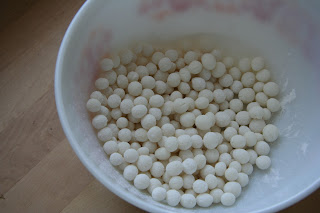 |
| A representative sampling of last year's squash crop. |
It is now March, and we still have a bit of butternut squash and some fairytale pumpkins looking painfully out of place next to our sprouting vegetable seedlings. In the spirit of spring cleaning, I thought I would try to make something out of the squash without resorting to using "pumpkin" spices.
Hobakjuk is a Korean squash porridge and requires very few ingredients - just sweet dark orange winter squash, water, sweet rice flour, sugar and salt. In addition, it requires quite a bit of discipline (you'll see). Coconut milk adds a little more richness to this very straightforward and filling soup.

Coconut Hobakjuk (adapted from Maangchi)
Rice flour balls:
- 2 cups sweet rice flour; keep extra flour on hand
- 1/4 teaspoon salt
- 3/4 cup hot water
- Time and/or friends
Soup:
- 4 1/2 - 5 pounds butternut squash or similar sweet dark orange winter squash
- 4 cups water
- 1 5.41 ounce can of coconut milk
- Salt to taste (I used 3 scant teaspoons)
- Sugar or other sweetener (such as agave nectar, honey, barley malt or molasses) to taste (I used about 3 tablespoons of barley malt and 1 tablespoon of sugar)
To make rice flour balls:
Boil about a cup of water. Add 3/4 cup of hot water to sweet rice flour and salt and thoroughly stir. After the dough cools a little bit, knead the dough for a minute or two, until flour is incorporated and a dough ball is formed (splash on a little more hot water if the dough seems too dry). Wrap dough ball in plastic wrap and let it rest for 20 to 30 minutes. Keeping the dough securely wrapped in plastic keeps it from drying out too quickly.
Before making the rice balls, thoroughly wash your hands. This is an important step, because you will be handling the dough with just your hands and this dough will pick up the tiniest lint off of your hands. Keep the dough covered in plastic wrap, but leave enough room open so you can access the dough at one end.
Are you in your comfy kitchen spot? Do you have some music playing or a friend nearby? This is important, do not skip this step. I listened to jangly alt-country songs and wistfully stared out of my sunny kitchen window while working through the dough. Trust me, find someone who will keep you company and help you.
Once you are ready, pinch off a bit of dough and roll between your palms to form a small ball. It's up to you how small (or big) you want to make the balls, but I recommend a size hardly bigger than a chick pea.
Put the completed ball into a bowl with about 3 tablespoons of sweet rice flour. Every so often, use your hands and stir the balls, making sure to coat them evenly with the flour.
This is what I had after one hour:
And done in about two hours, after contemplating the universe:
To make the soup:
Wash squash. Cut squash into large chunks and place in a large pot. Pour about three or four cups of water into the pot, cover and bring to a boil. Simmer for about 30 minutes, or until squash is tender. Remove squash to baking sheet to cool; discard water. Cut or peel off squash skin and discard. (Alternative method: wash squash, cut off or peel skin, place squash in large pot with three or four cups of water and simmer for 30 minutes, or until squash is tender).
 |
| I used a mix of butternut squash and fairytale pumpkin. |
Place peeled squash into pot and add about four cups of water and coconut milk. Using an immersion blender, puree soup thoroughly. (Alternative method: transfer portions of squash to blender or food processor to puree and return to pot; stir in water and coconut milk). Bring soup to a simmer and season with salt and sugar (or other sweetener), to taste.
*As an aside: I think it is really important that you keep tasting the soup to see if it tastes good to you. We are all different in terms of how we gauge sweetness and saltiness. Add salt and sweetener a little bit at a time, and pretend you are Goldilocks: you are looking for the spoonful that is just right.
Add sweet rice balls to soup and continue to simmer, stirring regularly. The rice balls will initially sink to the bottom of the pot and might stick, so you should let your spoon gently scrape the bottom of the pot every so often. The soup will be done when the rice balls float to the surface and are soft and chewy. Serve hot.


